 This information has been archived for reference or research purposes.
This information has been archived for reference or research purposes.
Archived Content
Information identified as archived on the Web is for reference, research or recordkeeping purposes. It has not been altered or updated after the date of archiving. Web pages that are archived on the Web are not subject to the Government of Canada Web Standards. As per the Communications Policy of the Government of Canada, you can request alternate formats on the "Contact Us" page.
Afghanistan
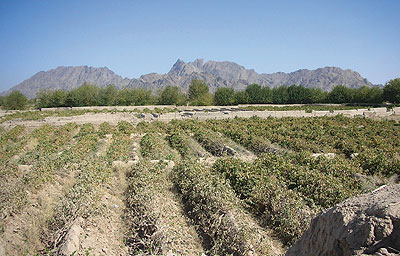
Author’s collection
The East flank of Strong Point Centre – vineyards and mud walls.
The Defence Of Strong Point Centre – 14 October 2006
For more information on accessing this file, please visit our help page.
The day started out as had all the others, it seemed, under a blue cloudless sky. Although still early in the morning, the relentless sun began to bake the soldiers of “Charles” Company of the 1st Battalion, The Royal Canadian Regiment Battle Group (1 RCR BG), also known as Task Force 3-06. The Canadian soldiers from Petawawa, based in northern Ontario, took the heat in stride. More irritating was the constant dust churned up by any movement, whether vehicle, human, or wind. The fine talcum powder-like sand covered everything, and it was impossible to keep anything clean. To add to the misery were the unremitting sand fleas and flies that tortured the soldiers without pause.
“Charles” Company was deployed in fortified outposts along a stretch of new road that was being constructed in the Pashmul area of Kandahar Province in southern Afghanistan in the aftermath of NATO’s Operation Medusa. This offensive operation had been designed to root out and destroy the Taliban, who had made the area a stronghold. In fact, Kandahar province, and this area specifically, was the heartland of the Taliban movement. In early September 2006, the International Security Assistance Force (ISAF) Multi-National Brigade, centered upon the combat power of Task Force 3-06, engaged the militants, killing hundreds and forcing the rest to withdraw.
The war, however, was far from over. Hard-core Taliban forces rapidly infiltrated back into the area. They simply blended back into the countryside and among the local population. They adopted guerrilla and terrorist tactics – intimidating locals and coercing them to provide support to the Taliban; planting improvised explosive devices (IEDs) and mines; deploying suicide bombers in vehicles, on bicycles and on foot; and conducting hit and run attacks against coalition forces throughout the area. This enemy was skilled and extremely clever. They quickly learned the limitations of the coalition’s capabilities and the constraints embodied in their rules of engagement (ROE). Thus armed, the Taliban struck back swiftly with some effect. As a result, the security situation had once again deteriorated, and Canadian casualties began to mount.
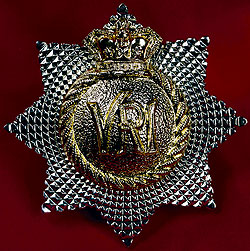
The cap badge of The Royal Canadian Regiment
Despite this renewed activity by the Taliban in the wake of the destruction wrought by Operation Medusa, there was considerable pressure brought to bear by ISAF Headquarters, as well as from national and international governments, to press on with reconstruction in order to demonstrate that progress was being made. Although still engaged in a deadly struggle with Taliban forces, the battle group did what it could.
The construction of the road appeared to be a good place to start. It would serve a twofold function. First, it would fulfill a security requirement. The only existing route through the area was a narrow dirt road that snaked its way through closely directed and restricted (canalizing) terrain that cut through built-up areas and a complex array of compounds. As such, it was impossible to secure and a nightmare to traverse. Most armoured vehicles were simply too large to transit it. Moreover, IEDs and ambushes were a constant threat in an environment that favoured attackers.
The new road would cut a straight 100-metre-wide swath through the marijuana fields and grape vineyards. Its wide berth and straight trajectory would provide easy observation, control, and security. More importantly, this modern, easily accessible road, which would eventually be paved, would furnish local farmers with an excellent route that would allow produce and trade to transit from the fertile Arghandab River Valley to Highway 1, the major artery leading to Kandahar City and beyond.
But before these two major benefits could be reaped, the road had to be completed. This was no easy task. The Taliban harassed the thinly stretched troops persistently. During the night, they would stealthily plant IEDs and mines in the sandy furrow that then represented the road. In addition, they would deploy small teams that would attempt to surprise and ambush the Canadian troops. And they had already immobilized two bulldozers and several other vehicles, through IED and mine strikes.
The 1 RCR BG soldiers faced a formidable task. With a very active area of operations (AO) spanning approximately 60,000 square kilometres, the battle group was stretched thin. Exacerbating this challenge was the fact that in less than two months, TF 3-06 had already suffered 15 soldiers killed in action and a further 85 wounded. Very few replacements had yet arrived; yet the scheduled leave plan had now also “kicked in,” and some troops were being rotated out of theatre for the three weeks of leave that they were entitled to during the six-month tour of duty.
To compound their problems even more, the terrain was a soldier’s worst nightmare. Marijuana fields as high as nine feet tall obscured visibility, even when observing from a turret of a Light Armoured Vehicle (LAV) III. The plants also absorbed energy and heat very readily. As a result, it was very difficult to penetrate the forests of ‘pot’ with thermal surveillance equipment. Burning the fields with white phosphorous and diesel fuel also failed, because the plants were still too full of water. All these factors afforded the Taliban a high degree of freedom of movement.
However, these conditions were only part of the problem. The rest of the landscape was covered by grape vineyards consisting of an array of one-metre-high dirt walls spaced approximately a metre apart, upon which the vines grew. These provided additional protection from which to fire, or to move across the battlefield. And then there was the large array of buildings and compounds and other walls, as well as 10-metre-high grape-drying huts with firing ports already built in that existed throughout the area. These structures, as well as all others, were virtually impregnable strongholds as their walls were anywhere from .5 to 1.5 metres thick. They were constructed of a mix of mud, thatch, and straw. However, once they had dried and baked in the heat of the sun, they were as solid as concrete andcould only be penetrated by powerful munitions. In addition, the entire area was interconnected with a canal system that permitted concealed, high-speed dismounted approaches throughout the battlefield.
To assist “Charles” Company in securing the road construction, Afghan National Security Forces (ANSF), after weeks of cajoling the Afghan national government, were finally sent into the area. However, although they were welcomed, they were of limited value. The Afghan National Army (ANA) troops that arrived were relatively professional, adequately trained, and ready to enter battle, as long as they had Canadian accompaniment, but there were just too few of them. Instead of the 300 promised, only a small group of approximately 40 arrived to assist the Canadians.
Conversely, the Afghan National Police (ANP) were qualitatively on the opposite extreme of the spectrum. Young, untrained, and answerable directly to the governor of the province, they resembled and behaved more like common thugs than police. They wore no uniforms, and they were notoriously corrupt and untrustworthy. Significantly, large elements therein were suspected of being sympathetic to, if not in league with, the Taliban.
Within this context, “Charles” Company began yet another normal day in what arguably could be called Afghanistan’s answer to the “Wild West.” As the experienced and hardened commanding officer of the battle group, Lieutenant-Colonel Omar Lavoie, rolled down the new road under construction with his four vehicle convoy to coordinate with his sub-units and to verify defences and progress being made, he came across 1 Section, 9 Platoon, of “C” Company, (Call Sign 33A). Their LAV III, which was located halfway between the 7 and 9 Platoon positions, had backed over an IED, and the vehicle had become what is known as a mobility kill. Luckily, no one had been injured. However, the task force had just lost another precious vehicle that would be hard to replace.
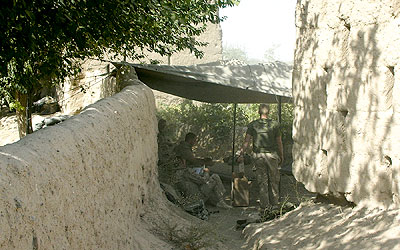
Author’s collection
Members of 7 Platoon seek shelter from the burning sun while not on immediate sentry duty. An ANA detachment is deployed on the other side of the wall.
Significantly, the IED had been placed in the middle of the unfinished road approximately 400 metres from 7 Platoon’s defensive position, which was co-located with a small ANA detachment. Consequently, everyone was mystified as to how this had transpired. How had the “ghosts of Panjwayi” planted the device without being seen? But an IED strike was not an uncommon occurrence, and efforts soon turned to recovering the vehicle back to their staging point, known as Patrol Base Wilson.
As the morning wore on, members of 7 Platoon continued with their surveillance duty in the increasing heat. Those not on duty within the LAV III or at sentry positions sheltered themselves under a tarpaulin behind the protection of a low wall, situated between two buildings that had been partially destroyed during Operation Medusa. On the opposite side of the wall ran a canal in which an ANA detachment had taken residence. The ANA manned several observation posts that were constructed to control the old road and the terrain to the west.
The members of the platoon had now been in the field in this threat environment for 23 days straight. They slept, ate, and tried to relax in the filth that surrounded them. When they slept, it was on Therm-A-Rest™ mattresses spread on the ground with their body armour at their side. Water was in short supply, and facilities were lacking – washing clothes was unheard of, and even personal hygiene was limited. The incessant dust covered everything and made maintenance of weapons and vehicles a constant concern. Conditions were primitive, to say the least.
At approximately 1100 hours, a radio message arrived, stating that a group of three Taliban had been seen to the west of 7 Platoon’s position. Warrant Officer Ray McFarlane, the platoon warrant officer and second-in command, and Sergeant Donovan Crawford, quickly coordinated with the ANA detachment. After patiently trying to convey the message to the ANA leader, who understood some English, and accompanied by a large degree of innovative sign language, the message was passed and the ANA was mobilized. With members of 7 Platoon close at hand, their 60mm mortar ready to engage in the fight, the ANA sent a small patrol out several hundred metres from the position to investigate the sighting.
Excited voices could soon be heard close by, followed by the “whoosshh” of an RPG 7 rocket and some small arms fire. Within minutes, the ANA soldiers returned with huge smiles, gesturing with waves of the hand and a simple, “Taliban gone.” Warrant Officer McFarlane was unable to ascertain whether the Taliban had been killed, or if they had simply scattered. Both questions elicited the same grunts and nodding of heads from the ANA patrol. Nonetheless, the threat seemed to have dissipated for the moment.
Meanwhile, several kilometres down the road to the south, 9 Platoon (Call Sign 33) manned their position. This had been given the designation of Strong Point Centre, aptly named since it was the middle position within the battle group’s defensive network. This network followed the path of the new road from Patrol Base Wilson on Highway 1, to the imposing Ma’Su~m Ghar mountain feature, where “A” Company, seconded from the 2nd Battalion, Princess Patricia’s Light Infantry (PPCLI), was constructing the new Forward Operating Base (FOB) Zettlemeyer. Strong Point Centre was a formidable position centred around an imposing mud structure, built upon a small outcropping that dominated the road and the surrounding area.
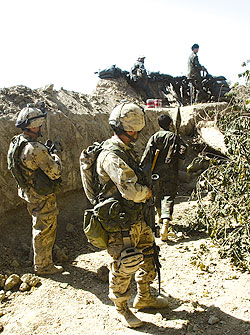
DND photo by C.L. Penney,
Combat Camera
Members of 7 Platoon support ANA operations in Pashmul.
The platoon used the natural lay of the land to anchor their defence. Two LAV IIIs flanked the position, and covered the western approach and the road. To their front lay a 100-metre swath of sand, and beyond that, marijuana fields, grape vineyards and an array of mud compounds and grape-drying huts. Fields of view were limited. Sheltered behind the large mud building that was the centre point of the defensive position, protected by a natural wall to its other side, another LAV III aimed its deadly cannon to the north, providing cover to the road approach. Finally, dug into this raised island that constituted Strong Point Centre, were two machine gun pits. One faced south to control the road, while the other faced east to cover the close terrain, mainly grape vineyards, which extended right up to the defensive position. The platoon had also augmented the natural fortress with a series of sandbagged walls to provide additional protection and fighting positions.
Much as was the case with 7 Platoon, the soldiers divided their time between sentry duty in the LAVs or in the machine gun posts, and in catching up on sleep or a meal. Manpower was particularly limited, since the section involved in the IED strike that morning was getting checked out medically back at Patrol Base Wilson for any injuries possibly sustained during the blast. A minimal diversion was also present, as the platoon played host to a number of visitors. A local district chief, his ANP bodyguard, and civil-military affairs (CIMIC) personnel were conducting an on-site meeting to discuss the progress of the road. In addition, a combat cameraman and a senior officer on a technical assistance visit were also present. However, the incidents of the morning seemed to harbour no sinister omen and they were already largely forgotten. After all, those types of events were virtually everyday occurrences in this theatre of operations.
Back at 7 Platoon, at approximately 1430 hours, the gunner in the turret of the LAV covering south along the road and the vast fields to the east, summoned Warrant Officer McFarlane. Out in the grape vineyards, approximately 200-300 metres away, six men, ostensibly “farmers,” as they carried no weapons, calmly walked south through the fields in single file towards a large grape-drying hut located approximately 400 metres from 7 Platoon’s position. ROEs forbade firing upon unarmed civilians, regardless of how suspicious they appeared. The Taliban were aware of this constraint, and they utilized their ability to blend in with the normal farmers to their advantage. Identifying friend from foe is one of the greatest challenges in this environment. The task force soldiers observed fighting age males in the fields on many occasions, but whether they were legitimate farmers or Taliban posing as such was difficult to ascertain. With cached weapons dispersed throughout the area, the enemy could transform from one to the other, and back again very quickly. Determining who was the enemy, as well as physically being able to dominate the ground and sweep it for weapons, was almost impossible, due to the shortage of personnel.
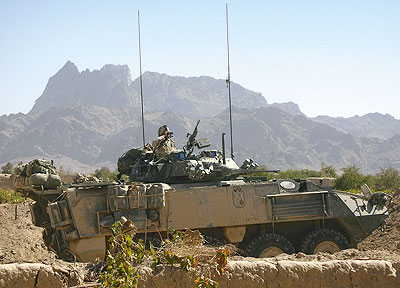
Author’s collection
A 7 Platoon LAV III watches the new road.
Lacking manpower to send a patrol to investigate, Warrant Officer McFarlane attempted to dispatch the ANA to go and probe the situation. However, the ANA similarly claimed they lacked the troops to wander out into the fields to scrutinize the suspicious party. Quite simply, without direct Canadian participation, they would not venture forth. As a result, McFarlane was forced to try to maintain surveillance upon the individals as long as possible, since he was unable to take any other action. Not surprisingly, the “farmers” quickly melted away into the maze of walls, buildings, and vegetation.
At approximately 1450 hours, the visitors started to congregate at the front of the position to await the commanding officer’s convoy. Lieutenant Ray Corby, the 9 Platoon Commander, had taken over the unit three weeks prior, when the casualties incurred in the early days of Operation Medusa had triggered a reshuffling of personnel. Corby was proud of his platoon and all they had already endured, and was confident about their current position, which was well sited and very defensible.
While waiting for the vehicles to arrive, Corby made an effort to speak to the district chief, but the young lieutenant was brushed off. As a result, Corby turned his attention to the CIMIC detachment commander, Chief Warrant Officer Fred Gratton. However, he was then interrupted three times in a span of less than 10 minutes by the district chief, who persistently asked when his ride would be arriving. During that same period the district chief received two cell phone calls, and placed a third call himself. He appeared desperately eager to leave.
Lieutenant-Colonel Lavoie arrived at Strong Point Centre at approximately 1455 hours, and he dismounted to discuss details of the earlier IED incident briefly with Lieutenant Corby, while the visiting personnel at the location loaded onto the vehicles that made up the commanding officer’s tactical headquarters (Call Sign 9er Tac). Just as the vehicles were in the midst of loading, a threat warning came over the air – “a Canadian position was under imminent threat of attack.” The grid reference provided was uncomfortably close to their current position. The soldiers had learned to dread these threat warnings – they were more often than naught accurate. Inside Strong Point Centre, the warning was relayed verbally to Lieutenant Corby. However, as he formulated his next course of action, the initiative was wrested away from him. Not even a minute passed from the time he was given the notice until all hell broke loose.
The initial barrage of enemy fire caught the soldiers of “Charles” Company by complete surprise. The attack was initiated by multiple RPGs being fired at the position. A minimum of three RPGs were fired in close succession, targeting Call Sign 33B, which was manning the southwest perimeter of the position, an empty trench on the western flank of the strongpoint, and the observation post located on the southeast of the defensive that contained a C-6 general purpose machine gun (GPMG). A high volume of small arms fire also hit the position, some of the rounds impacting short and kicking up the dust on the new road, while others cracked over the heads of the company troops.
Lieutenant Corby was in the midst of discussing the platoon’s course of action with Sergeant Jamie Walsh. As the RPG rockets and small arms fire rained in, their reaction was immediate. Corby and Walsh dove for cover behind a small berm behind Call Sign 33C, the LAV located in the centre of the position. From this vantage point, looking towards the south-west, they could see smoke coming from the tree line and marijuana fields, as well as rounds splashing towards them across the sand of the new road. The dust kicked up by the fire quickly obscured the visibility. However, it seemed the concentration of the enemy attack was coming from the west so that the enemy could use the bright sun to mask their movement and to blind the defenders.
Those on sentry duty responded with alacrity. The 25mm cannons on the LAVs, aided by thermal sights that could see through the dust, thundered in reply, supported by light-machine guns (LMGs) and GPMGs. The other troops quickly manned their fighting positions.
When the storm struck, Private Jess Larochelle was positioned in the southern-most machine gun pit. The enemy attack washed over him like a rogue wave. His position erupted in explosions as bullets and shrapnel hissed through the air around him. Larochelle thought he was hallucinating when he witnessed what he perceived as mini-explosions going off above his outpost. Little did he realize at the time that the enemy was using RPG munitions that emitted mini cluster rounds from their 75mm warheads, which, in turn, exploded, spraying deadly shrapnel, much like an air-burst round. Despite the weight of fire directed upon him, Larochelle continued to fire back at the tree line at his invisible antagonists.
Close by, the commanding officer’s tactical headquarters had just started to roll when a RPG rocket swished to the rear and exploded in a ball of flame approximately 80 metres behind the convoy. Mere minutes earlier, Lieutenant-Colonel Lavoie, the platoon commander and others had been standing in that exact spot. The three LAVs and the RG-31 Nyala armoured vehicle, which made up the tactical headquarters, all swung around and immediately began to engage the enemy, adding an enormous amount of fire into the fields and buildings to the west from where the enemy assault was originating. The enemy was now being pounded by a hailstorm of return fire.
Unfortunately, this all came a bit too late. As the “pum-pum-pum” of the 25mm cannons echoed across the battlefield, the first situation report (sitrep) cut through the noise of the battlefield and hit everyone as if they had been struck through the heart with a spike – “two VSA [vital signs absent], three wounded.” Stark reality had once again played itself out. The Taliban are little match for the western forces in either training or equipment. They rely on surprise, through IEDs, mines, or ambushes. They depend upon success in the first 30 seconds of an engagement before they become engulfed in return fire. Once again, they got lucky.
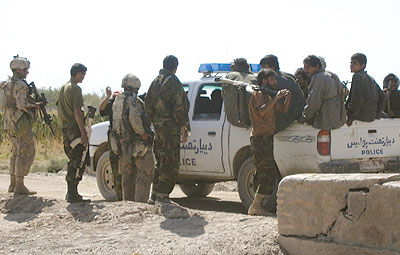
Author’s collection
“C” Company soldiers and ANA stop and question a vehicle of non-uniformed ANP members.
The crew and section of Call Sign 33B were resting when the attack commenced. Private Jesse Kezar was in the driver’s hatch, and Corporal Jeremy Penney was in the gunner’s seat when the initial barrage of fire hit. Corporal Penney attempted to fire the 25mm gun, but the cannon jammed. Corporal Darryl Jones was in the process of moving into the turret from the rear of the LAV when the RPG round struck near the vehicle’s laser warning tower. The resultant explosion showered the area with shrapnel, as lethal shards of metal and blast washed down through the rear air sentry hatch and over the back deck, killing one soldier who had been seated on the left bench and wounding another, who was seated on the right bench. The same round also killed the section commander and wounded two others, who were at the back of the vehicle.
At exactly the same moment, 1500 hours, 7 Platoon was also attacked. RPK machine gun fire and RPGs engulfed the surprised troops. Bullets stitched their way along the wall that soldiers earlier had rested against, kicking up dirt and forcing all of them to find cover. The fire emanated from the grape-drying hut the six “farmers” had been approaching earlier. However, the platoon replied in rapid succession, bringing all its firepower, as well as that of the neighbouring ANA, to bear. During the contact, as many as 20 to 30 enemy personnel were sighted in this area alone. Notwithstanding the enemy’s strength, the situation was brought under control.
Back at 9 Platoon, Sergeant Walsh organized his section to better engage the enemy in their location. He placed Corporal Nick Damchuk, Private Jay Royer, and Private Garret Achneepineskum behind a small berm, directly behind his LAV III, Call Sign 33C, where they laid down suppressing fire to the area west of the stronghold. Sergeant Walsh then deployed Corporal Chris Saumure and Private Ed Runyon-Lloyd to the front of the LAV to observe for enemy activity to the east of the position. Corporal Mike Lisk was in the turret of Call Sign 33C, and Master-Corporal Rob Murphy, who used the small escape hatch on the LAV to crawl up into the turret, soon joined him. Due to the lack of enemy activity in their primary arcs to the northeast of the position, Master-Corporal Murphy traversed the turret over the back deck of the LAV, so that the cannon could be directed to the southwest. He then used the height of the pintle-mounted machine gun to fire over the high feature to their front, adding extra firepower to the fight. All the while, Corporal Jeff Morin began redistributing ammunition to the section, since the tempo and intensity of the combat had quickly depleted the immediate supply.
Simultaneously, Lieutenant Corby rapidly moved to his headquarters LAV, sited upon the north side of the position, to ensure that a contact report had been transmitted. As he neared his vehicle, he could see the occupants busily engaging a large number of enemy personnel directly to the west. Corporal Morgan Gonci had been in the driver’s hatch before the attack. As the first few rockets exploded nearby, he could feel the LAV shake. Corporal James White, observing from the gunner’s seat, also felt Call Sign 33 reel as a RPG rocket hit the front right side of the vehicle, ripping off some of its upper-armour plating. At the onset of the attack, Sergeant Craig Dinsmore crawled up through the rear of the vehicle into the crew commander’s seat, and Corporal Gonci immediately began to provide target indication from the driver’s hatch. Simultaneously, Corporal Shane Robertson and Corporal Joey Paolini jumped into the back of LAV and raised the ramp. When Lieutenant Corby arrived, he banged repeatedly on the back door until it was opened. He then instructed Robertson and Paolini to provide security to the north of Call Sign 33, in order to ensure the enemy did not outflank their position.
Corby now took a headset and sent a supplementary contact report on the company net. He also requested a fire mission, sending his exact location, the distance to the enemy, and the relative bearing. Fortuitously, Major Greg Ivey, the commanding officer’s affiliated battery commander, who travelled in the 9er Tac convoy, was already in the process of calling in artillery support. Within 10 minutes of the start of the engagement, 155mm rounds exploded with an earth shaking “krummpp” 400 metres away, close to Strong Point Centre. In addition, word was passed over the net that “AH” (Apache attack helicopters) were on their way inbound.
Satisfied that the call for fire had been acted upon, Corby now tried to raise his sections on the radio to get a more accurate read on the battle. He began with the observation post possessing the GPMG, as it occupied the highest vantage point. However, he then became concerned when he received no reply. His second call went to Call Sign 33B, located to the south of the position. Corby received a sitrep from Corporal Jones, who was in the turret of the 2 Section LAV. Jones informed the platoon commander that they had two casualties who were “vital signs absent.” He also requested that the assigned medic come to his location to look after the other three wounded soldiers. Corby questioned Jones on the extent of the other injuries, and determined that they were not critical. Luckily, there was an advanced-qualified soldier in situ to administer first aid. However, that individual, Master-Corporal Jeremy Leblanc, was in dire need of additional medical supplies. As a result, Corby decided not to risk his only medic, who was stationed in the headquarters LAV, by sending her across exposed terrain in light of the heavy volume of enemy fire. Instead, Corby grabbed the medical bag and made his way to 2 Section’s location himself. Meanwhile Corporals Paolini and Robertson, positioned on the outside of the headquarters vehicle, were busy engaging the enemy. Between these two soldiers, they experienced two separate groups, five individuals in total, with small arms and RPGs engaging their position alone.
Out on the road, the commanding officer’s convoy continued to pour fire into the buildings, the wood line, and the marijuana fields. Call Sign 9B2, commanded by Captain Chris French, the forward deployed operations officer, developed a malfunction with their 25mm cannon. As a result, when the call came from 9 Platoon Headquarters that they were in desperate need of ammunition, Captain French rushed his vehicle over to Strong Point Centre. Dropping the ramp, Corporal Nick Friesen and one of the passengers grabbed heavy cans of ammunition and dashed across the open ground, ducking into Call Sign 33 to deliver the badly needed supplies. They were joined immediately by Corporal Robinson, who assisted in the hauling of ammunition. The original two stalwarts of this particular effort would later make a similar dash to pick up casualties, only to learn that the issue had already been settled – such is the confusion of combat.
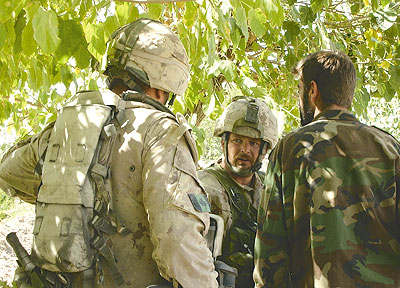
Author’s collection
Warrant Officer Ray McFarlane discusses the ANA response to a possible Taliban sighting. Although not realized at the time, the Taliban were probably conducting a reconnaissance for the attack later that day.
At the same time, Lieutenant Corby moved back to Call Sign 33C, which occupied the centre of the platoon position. He looked across at Call Sign 33B, and could see that the turret was still firing. He quickly informed Sergeant Walsh of his plan to run the medical bag, first to the observation post, then to Call Sign 33B’s location. Corporal Damchuk and Private Achneepineskum then proceeded to lay down a wall of suppressive fire as Corby made his mad dash.
To get to 2 Section’s LAV, Corby first had to pass by the southernmost observation post. He did not expect to find anyone alive. As he arrived at the geographical bowl in the centre of the strongpoint position, which was also the casualty collection point, he was able to see the observation post. At first glance, it had appeared that the post had been struck hard. He could not see anyone. The tarpaulin that had been strung above the outpost to provide shade had been torn away by gunfire, and it hung in tattered rags. Close by, he could see the empty casings of four M72 launchers.
Corby called out twice towards the observation post, and finally got a response. Private Larochelle poked his head up and confirmed he was “okay,” and “by himself.” Corby then directed Larochelle to provide covering fire so that he could enter the observation post. Larochelle then began to point out where he had been engaging the enemy with his C-9 LMG, the C-6 GPMG, and the M72s. The firefight had been so intense that Larochelle was down to his last half-belt of 7.62mm GPMG ammunition. However, he had weathered the storm and continued to fire at any movement or weapon signature he could see. He also had maintained his combat discipline and continued to observe his arcs of fire, in order to ensure no enemy was approaching from the east, even though he was taking heavy fire from the west.
Corby was humbled by the young soldier’s valiant efforts. However, he had no time to reflect upon Larochelle’s courage at the moment – there was work to be done. Corby now instructed Larochelle to lay down more fire so that he could make his final way to 2 Section’s, LAV, Call Sign 33B. Corby promised that when he returned, he would bring additional ammunition.
After the first deadly RPG strike, Corporal Jones had remedied the gun malfunction and started to return fire. A second RPG round then hit Call Sign 33B, setting off the automatic fire extinguishing system in the vehicle. When Lieutenant Corby arrived, he quickly recognized that they had, in fact, suffered two fatal casualties. Master-Corporal Leblanc, who himself was wounded, had bandaged up the casualties, while the rest of the section were on the line busy returning fire from a sandbagged wall they had constructed adjacent to the LAV position. Once they were patched up, Corporals Chris Dowhan and Chris Meace also joined their section on the firing line.
By this time, the company soldiers were about 15 to 20 minutes into the fight. Corby then sent another sitrep to his company headquarters. He then learned that the company second-in-command was on the scene with numerous other LAVs to lend a hand. Corby recommended that these additional troops form a firing line north of his position and orientate themselves to the southwest, so that they could assist in suppressing the enemy’s heavy fire into Strong Point Centre.
As these battle dispositions were being discussed, Corporal Jones reported a second stoppage of the cannon. Master-Corporal Leblanc, despite his wounds, switched places with Corporal Jones in an attempt to rectify the stoppage. However, as Leblanc rapidly became faint and weak from the loss of blood he already suffered, he was pulled from the turret, and Corporal Jones returned to do what he could.
Once Lieutenant Corby learned that 1 Section, which had fallen prey to the IED in the morning, were on their way back out with a replacement LAV, which was pristine-new off the assembly line, and that the Bison ambulance was now disabled, he decided to use Call Sign 33B to evacuate the dead and wounded to Patrol Base Wilson. This would get his men back for medical attention swiftly, and Call Sign 33A could now provide the necessary reinforcements and added firepower.
By now, the Taliban had been largely suppressed. The weight of fire and the dreaded artillery, which had impeded enemy movement, swung the battle to the advantage of the task force soldiers. However, this was no surprise to the Taliban. They were very aware of Coalition tactics, techniques, and procedures, and they knew exactly how long it would take reinforcement or augmentation Coalition resources to be fed into the battle. To further complicate the Coalition responses, the Taliban often coordinated attacks to buy them more time. Today, they had hit simultaneously at five different locations throughout the area of operations.
The sense of purpose that had prevailed throughout the fight was not surprising, but the resounding, demonstrated calmness was very commendable. The small engagement had been compounded by additional problems, the “friction” of war. As the 9er Tac convoy jockeyed for firing positions during the fight, one LAV became hung up in a small ditch and required a quick tug to make it mobile again. More seriously, the Bison armoured ambulance that was on its way to pick up the casualties hit a small wall that broke its right front tire. The driver tried valiantly to limp his vehicle into Strong Point Centre. However, the rough terrain just exacerbated the damage and the vehicle had to be abandoned. Its personnel were then cross-loaded into Call Sign 33A and delivered to 9 Platoon.
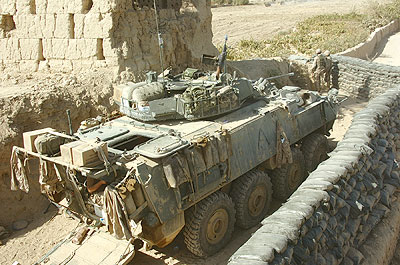
DND photo AR2006-P020-0043 by C.L. Penney, Combat Camera
The centre of Strong Point Centre – Call Sign 33C.
By 1530 hours, Corby had moved back to the observation post to link up with Private Larochelle. Once there, he used the radio to speak with company headquarters. At the same time, he noticed that the company quartermaster sergeant, Warrant Officer Keith Olstad, who was also the acting company sergeant-major, had arrived with the 7 Platoon Commander, Captain Wessan, in order to recover the wounded and to provide a re-supply of ammunition. By this time, the platoon second-in-command, Warrant Officer Scott Robinson, had also arrived. Back at Patrol Base Wilson with the damaged LAV from the morning’s IED hit, the moment he heard his platoon was under attack, he gathered up 1 Section and a new LAV and rushed to the engagement area. About 100 metres out from the strongpoint, he realized he could not bring the LAV in closer because of the heavy outgoing fire. Therefore, he dismounted and covered the last part on foot, leaving Call Sign 33A to join the ring of steel outside the strongpoint in order to pour fire into the Taliban positions.
Upon entering the 9 Platoon position, Robinson was quickly briefed by the platoon commander on the plan, and events quickly unfolded from there. Warrant Officer Olstad completed the re-supply of 2 Section, and the dead and wounded were loaded into the back of Call Sign 33B. Master-Corporal Leblanc insisted on staying on in position, but Corby ordered him out. However, the tenacious Leblanc would render one more service. So short on the ground was Corby that he needed the wounded Leblanc to crew command the vehicle back to Patrol Base Wilson. As the replacement LAV, Call Sign 33A, worked its way into position, Call Sign 33B departed the area post-haste, and Call Sign 33A took up its position in the defensive line. With the added reinforcements, Corby augmented the observation post with additional personnel, who then provided Private Larochelle with some badly needed support and a re-supply of ammunition.
As Call Sign 33B hastily departed the area, Captain French quickly took off in pursuit. The security situation necessitated that vehicles travel as a minimum in pairs so that there was mutual support, security, and assistance should a vehicle hit a mine, an IED, or get ambushed. Moreover, the heavy fighting had depleted stocks of ammunition, and despite the re-supply, additional ammunition was desperately needed. Call Sign 9B2, part of the commanding officer’s tactical head-quarters, was one of the only vehicles available to do the job. As it was, Lieutenant-Colonel Lavoie remained in the firing line to provide badly needed fire support. Manpower and vehicles were stretched so thin that the unheard-of had become necessary. Thus, the commanding officer had been involved intimately in the actual fight.
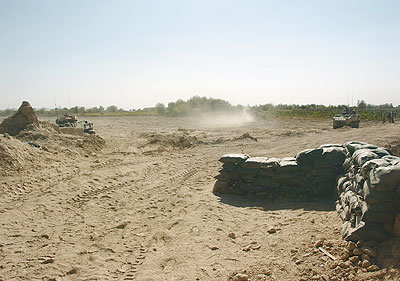
DND photo AR2006-P020-0042 by C.L. Penney, Combat Camera
A view from the south-west corner of Strong Point Centre minutes prior to the attack. The CIMIC party can be seen in the middle of the new road next to one of the CO’s Tac HQ LAV IIIs. The brunt of the attack was launched from the treeline on the far side of the new road.
With the enemy suppressed and the dead and wounded evacuated, Lieutenant Corby now put his thoughts to securing the position for the night. He quickly briefed Sergeant Joe Power, the 1 Section Commander, whose vehicle had replaced Call Sign 33B on the southern flank of the strongpoint, to get himself organized for holding the position for the night.
Several kilometres away, the two LAVs that had just left the strongpoint exploded through the gates of Patrol Base Wilson. The entire garrison, at least those not on sentry duty, were waiting to respond. Warrant Officer Steve Konyenburg and the medical team immediately took control of the dead and wounded, and arranged the medical evacuation. An American Blackhawk helicopter was already en route, and it would arrive within minutes. At the same time, Warrant Officer Richard Melo had a work party standing by to load ammunition and combat supplies. As Call Sign 9B2 pulled up and lowered its ramp, cans of ammunition were quickly passed forward. The interior of the LAV was literally stuffed with ammunition, occupying every inch of available space, right up to the roof. Only a small area was left open in the rear, so that the rear sentries could man the back hatches. The comment: “This will sure ruin our day if we get hit,” elicited a dry retort from Corporal Friesen: “Well, at least we won’t feel a thing.”
Once uploaded, arrangements were made to bring a 10-ton wrecker to recover the disabled Bison ambulance. The key concern, however, was finding the second escort vehicle. With Patrol Base Wilson already depleted of manpower, Captain French approached the surviving crew of Call Sign 33B. “I need you,” he simply stated, and to a man, and without hesitation, they quickly manned their LAV and fell into the three-vehicle convoy.
As the convoy crept through the gates of Patrol Base Wilson, darkness had descended. It was pitch black as the small packet of vehicles inched its way over the sandy terrain that represented the new road under construction. The sound of fighter aircraft streaking over the route and defensive position was reassuring. F-18 Hornet and F-16 Fighting Falcon fighter aircraft remained on station the entire night, providing observation and fire when required. At one point, an air strike lit up the darkness with a bright orange wall of flame – a beautiful sight in a macabre sort of way.
And then, battlefield “friction” kicked in once again. The driver losing sight of the roadway in the dark, the 10-ton wrecker became stuck, and, in the process of trying to get out, he blew the driveshaft. The weight of the wrecker and the soft sandy soil negated use of the LAVs as a means of extraction. There were now two vehicles disabled. Then, the second escort LAV, Call Sign 33B, which had sustained some damage to its turret earlier, began to “red-line.” With two more vehicles disabled, stopped in close country with a LAV full of ammunition, Call Sign 9B2 was in a potentially precarious situation.
Once again, the commanding officer shuffled his scarce resources to accomplish the mission. Two engineer LAVs towed the Bison ambulance to 9 Platoon’s position for security for the night. They then proceeded to Call Sign 9B2’s location, where one LAV remained as security while the other acted as an escort, so that the ammunition could be delivered to Strong Point Centre.
Once the ammunition was downloaded, and to ensure that the position was secure for the night, the commanding officer directed reinforcements from “Bravo” Company, specifically, 2 Section, 4 Platoon (Call Sign 21B), be dispatched to support 9 Platoon. This provided a fourth LAV, as well as dismounted infantry, that permitted Lieutenant Corby to solidify his northern flank.
As further testimony to the strain the large area of operations places upon the battle group, once Lieutenant-Colonel Lavoie was convinced that Strong Point Centre was secure, he transformed his resources into a recovery/escort role. The engineer bulldozer used to carve out the road, and driven by Master-Corporal Lance Hooper, who had already had two bulldozers blown up under him, was now employed to tow the 10-wrecker back to Patrol Base Wilson under the security umbrella of the commanding officer’s tactical headquarters convoy.
During this time, an updated threat warning was received that indicated the enemy was still planning to press attacks throughout the night. However, they would do so as individuals in order to avoid further risk to themselves. Their earlier attacks had been a coordinated effort that resulted in five simultaneous attacks in the battle group’s area of operations. The attack against Strong Point Centre was one of the larger strikes. In any case, the continued threat meant that for 9 Platoon, from the time darkness descended upon the battlefield at approximately 1845 hours, until sunrise at 0600 hours, the platoon was required to remain at 100 percent alert and ready for action.
Throughout the night, the soldiers spelled each other off duty. While some remained vigilant, others cleaned their weapons in situ in preparation for the battle’s continuation. In addition, water and food was brought to their fighting positions and soldiers took turns eating and grabbing a few moments of sleep. Throughout the night Lieutenant Corby and his platoon second-in-command, Warrant Officer Robinson, remained awake and moved throughout the position to ensure all was secure.
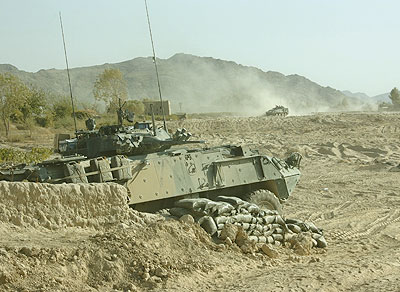
DND photo AR2006-P020-0010 by C.L. Penney, Combat Camera
Call Sign 33B minutes before the attack.
At 0700 hours, 4 Platoon arrived to relieve the exhausted 9 Platoon. The relief-in-place process went smoothly. 4 Platoon already had a section in place, and the entire platoon had already done a stint of duty at Strong Point Centre several weeks earlier. For 9 Platoon, it was a bittersweet moment. They had weathered the storm well and had shown resilience and courage. Unfortunately, they had also lost two of their comrades.
The pain of such loss ran deep, even with hardened men who had already given so much. Nowhere was the sadness more evident than in the unspoken actions of two individuals. On return to Patrol Base Wilson after the action, the commanding officer, the regimental sergeant major and a few others sat around exhausted. Little was said – yet, the silence spoke volumes. Quietly, Warrant Officer Olstad, walked up to the regimental sergeant major, Chief Warrant Officer Bob Girouard, with a very sombre, painful look on his face and a clenched fist. He then took Girouard’s hand in his own and placed two ‘dog-tag’ (identification disc) stubs into the sergeant-major’s palm. Bob Girouard closed his hand immediately with a firm grasp. Both men looked at each other and nodded. There were no words; yet, more could not have been said. The powerful message expressed in this simple ceremony conveyed the bonds of warriors, yet the infinite sadness of men. As the American general William Tecumseh Sherman once said so long ago: “War is hell.”
![]()
Colonel Horn, an infantry officer, is currently Deputy Commander of Special Operations Forces Command.
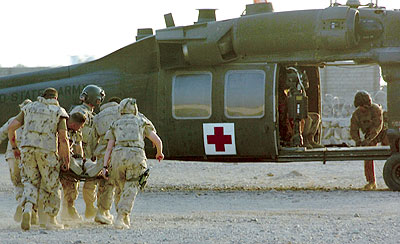
DND photo AR2006-P020-0027by C.L. Penney, Combat Camera
The casualties are evacuated from Patrol Base Wilson.






